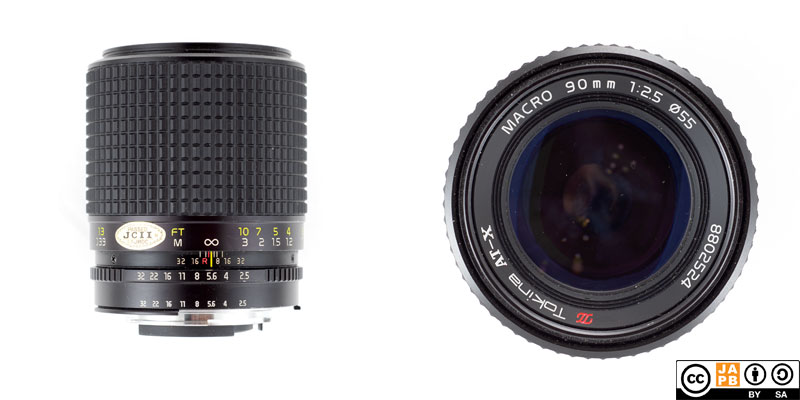Pekka Buttler, 03/2023

Specifications
The table below summarises the lens’ key specifications (measurements based on pictured sample):
| Brand: | Tokina | Lens name | AT-X Macro 90mm 1:2.5 |
| Focal length(s) 1 | 90 mm | Angle-of-view 2 | 27° |
| Maximum Aperture | f/2.5 | In Production | 1986–1997 |
| Lens mounts (this lens) | Nikon F | Other lens mounts | Canon FD, Contax/Yashica, Minolta SR, Olympus OM, Pentax K |
| Length 3 | 77,0 mm | Diameter 4 | 66,7 mm |
| Filter ring diameter | 52 mm | Weight | 513 grams |
| Lens element count | 8 | Lens group count | 7 |
| Aperture blades (S/R/C) 5 | 8 S | Focus throw | 290 ° |
| Minimum focusing distance | 39 cms | Maximum magnification | 1:2 |
| Has manual aperture ring | YES | Has Manual focus ring | YES |
| Aperture mechanism type | Automatic | Aperture click stops 6 | 2.5-4•5.6•8•11•16•22-32 |
Further notes:
• This lens is widely known as ‘the Bokina’ because of its especially pleasing way of rendering out-of-focus areas (both behind and in front of the focal plane).
• This lens has a maximum magnification of 1:2 at MFD. Tokina used to offer a dedicated ‘Macro extender’ that would bring the lens to 1:1. Interestingly, that ‘Macro extender’ was not just an extension tube, but contained some optics to improve close-up performance.
• Before 1986 Tokina produced a very similar lens exclusively for Vivitar (the Vivitar Series 1 90mm f/2.5 Macro). After Vivitar discontinued that lens, Tokina decided to redesign the lens slightly and sell it as part of the Tokina AT-X (premium) series.
• The Vivitar and Tokina versions differ in that the Vivitar version is more bulky (size, weight, filter thread) and in that Tokina upgraded the lens’ coatings before launching it as a Tokina lens.
• Alike all traditional macro lenses, the lens focuses by moving the entire objective (set of lenses) away from the film plane. Hence the focusing to MFD entails a significant lengthening of the lens (see below).
• Because the front-element is relatively exposed, using a lens hood might be advisable, even though the lens is not especially prone to flaring (any generic 55 mm thread short tele hood will do).
• This lens was later replaced by the ‘Tokina AT-X 100 AF PRO 100mm 1:2.8 Macro’.

Right: Focused at MFD
Adapting
Given that this lens exists in at least 6 different mount versions, the question of adapting is a bit complicated.
On dSLRs
If you have a Nikon F or Pentax K SLR/dSLR, you can use the Nikon F / Pentax K versions of this lens natively on your camera.
If you have a Canon EF or Sony/Minolta A dSLR, some of the versions of this lens (most prominently Nikon F) can be adapted using a simple adapter ring. However, metering will only work in stop-down mode.
On Mirrorless
Thanks to being a fully manual lens (manual aperture, manual focus), the lens can be adapted to all mirrorless cameras using a simple dumb adapter. Also, with most mounts that this lens was manufactured using, you will have a wide range of special adapters (e.g. helicoid adapters; tilt-shift adapters; speed boosters) available.
On Film
If you have a Canon FD, Contax/Yashica, Minolta SR Nikon F, Olympus OM or Pentax K Film SLR, you can use the respective versions of this lens natively on your camera 7.
History of Tokina
Tokina was originally founded in 1950 by a group of ex-Nikon engineers, went out of business once, launched a successful intermediate lens mount and is one of the few Japanese postwar optics startups that has survived to this day. Sort-of, at least. Read more in the JAPB company profile on Tokina.
Footnotes
- Focal length is (unless stated otherwise) given in absolute terms, and not in Full-frame equivalent. For an understanding of whether the lens is wide/tele, see ‘Angle-of-view’. ↩︎
- Picture angle is given in degrees and concerns the diagonal picture angle. Rule of thumb:
> 90 ° ==> Ultra-wide-angle
70–90 ° ==> Wide-angle
50–70 ° ==> Moderate wide-angle
40–50 ° ==> ‘Standard’ or ‘normal’ lens
20–40 ° ==> Short tele lens
10-20 ° ==> Tele lens
5-10 ° ==> Long tele lens
< 5 ° ==> Ultra-tele lens ↩︎ - Length is given from the mount flange to the front of lens at infinity. ↩︎
- Diameter excludes protrusions such as rabbit ears or stop-down levers. ↩︎
- S=straight; R=rounded; C=(almost)circular at all apertures. ↩︎
- Numbers equal aperture values on aperture ring; • intermediate click; – no intermediate click. ↩︎
- When doing macro photography on a Film SLR, remain mindful of effective aperture. ↩︎